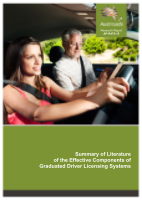Road Safety

- Publication no: AP-R476-15
- ISBN: 978-1-925294-05-7
- Published: 23 February 2015
- PDF (free) Download
This report provides the results of a review of literature examining the effectiveness of different components of graduated driver licensing (GDL).
Components examined included: minimum learner age, minimum learner period, minimum learner supervised driving hours, supervisory driver requirements, formal education requirements, licence tests, minimum provisional age, minimum provisional period, night driving restriction, peer passenger restriction, blood alcohol concentration limit, mobile phone or other technology restriction, vehicle power restriction and specific sanctions for speed, alcohol or other offences.
The project considered whether there was evidence that the component addresses a contributing factor to young driver crashes and/or injuries, and is effective in reducing young driver crashes and/or injuries.
The most well evaluated components, and therefore having the most examples of quantified benefits in terms of crash and/or injury reductions, were a minimum learner age of 16 years, a minimum learner period of 12 months, minimum provisional age greater than 16 years (with increasing benefits with increasing age), night driving restrictions, peer passenger restrictions and a zero BAC limit.
Much of the literature originated from North America, which differs to Australasia in both GDL and enforcement practices. Jurisdictions should continue to monitor GDL research, but also evaluate their own data to the extent possible to ensure the appropriateness of each GDL component to their jurisdiction.
- Summary
- Background
- Methods
- Results and Discussion
- Limitations and Other Considerations
- Concluding Comments
- Contents
- 1. Introduction
- 1.1. Project Background
- 1.2. Young Driver Crash Risk
- 1.3. Graduated Driver Licensing
- 1.4. Report Structure
- 2. Literature Review Methods
- 3. Current GDL Models in Australia and New Zealand
- 4. Overview of GDL Evaluation Literature
- 4.1. GDL Models in North America
- 4.2. GDL Evaluations
- 4.3. Searching for Guidance
- 5. Effectiveness of GDL Components
- 5.1. Minimum Learner Age
- 5.1.1. Conclusions: minimum learner age
- 5.2. Minimum Learner Period
- 5.2.1. Raising the minimum provisional age to extend the learner period for younger learners
- 5.2.2. Setting the minimum learner period
- 5.2.3. Conclusions: minimum learner period
- 5.3. Minimum Supervised Hours
- 5.3.1. United States Research
- 5.3.2. Australian Research
- 5.3.3. European Research
- 5.3.4. Balance of Evidence Regarding Number of Hours
- 5.3.5. Compliance with Supervised Hours Requirements
- 5.3.6. Requiring Supervised Hours at Night
- 5.3.7. Conclusions: Minimum Supervised Hours
- 5.4. Supervisory Driver Requirements
- 5.4.1. Conclusions: Supervisory Driver Requirements
- 5.5. Mandatory Formal Education Requirements
- 5.5.1. Mixed Pre-learner and Learner Education Programs
- 5.5.2. Learner Driver Education Programs
- 5.5.3. Provisional Driver Education Programs
- 5.5.4. Education on Safe Vehicles for Young Drivers
- 5.5.5. Conclusions: Formal Training or Education
- 5.6. Licence Tests
- 5.6.1. Theory/Knowledge Test
- 5.6.2. On-road Driving Test
- 5.6.3. Hazard Perception Test
- 5.6.4. Exit Tests
- 5.6.5. Conclusions: Licence Tests
- 5.7. Minimum Provisional Licensing Age
- 5.7.1. Conclusions: Minimum Provisional Age
- 5.8. Provisional Holding Period and Minimum Exit Age
- 5.8.1. Conclusions: Minimum Provisional Period
- 5.9. Night Driving Restrictions
- 5.9.1. Conclusions: Night Driving Restriction
- 5.10. Passenger Restrictions
- 5.10.1. Conclusions: Peer Passenger Restriction
- 5.11. Blood/Breath Alcohol Concentration Restrictions
- 5.11.1. Conclusions: BAC Limit
- 5.12. Mobile Phone or Other Technology Restrictions
- 5.12.1. Increased Crash Risk When Using Mobile Phones, Other Technology
- 5.12.2. GDL Restrictions on Use of Mobile Phones, Other Technology
- 5.12.3. Comment on Effectiveness of Mobile Phone Restrictions Generally
- 5.12.4. Conclusions: Mobile Phone/Other Technology Restrictions
- 5.13. Vehicle Power Restrictions
- 5.13.1. Conclusions: Vehicle Power Restriction
- 5.14. Specific Sanctions for Speed, Alcohol or Other Offences
- 5.14.1. Demerit Point Systems
- 5.14.2. Maximum Speed Restrictions
- 5.14.3. Alcohol Interlocks
- 5.14.4. Driver Improvement Programs
- 5.14.5. Good Behaviour Requirements and Regression to Previous Licence Stage
- 5.14.6. Conclusions: Specific Sanctions for Speed/ Alcohol/ Other Offences
- 6. Discussion
- 6.1. Summary of Results
- 6.2. Limitations and Other Considerations
- 7. Concluding Comments
- References
- North American GDL Models
- A.1 United States (Insurance Institute for Highway Safety, 2013)
- A.2 Canada (Traffic Injury Research Foundation, 2013)
- A.2.1 GDL New Drivers: Learner Stage (Stage 1) at a Glance
- A.2.2 GDL New Drivers: Learner Stage (Stage 2) at a Glance
- A.2.3 GDL New Drivers: Additional Novice Stages at a Glance
